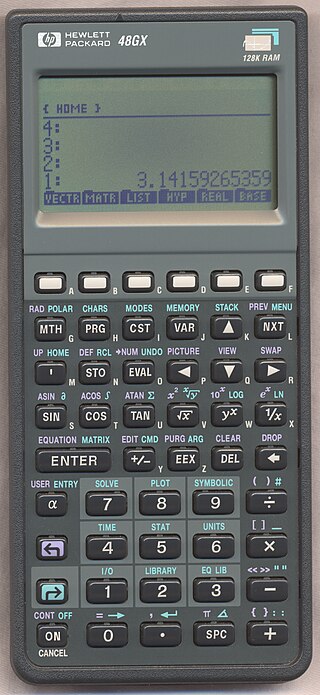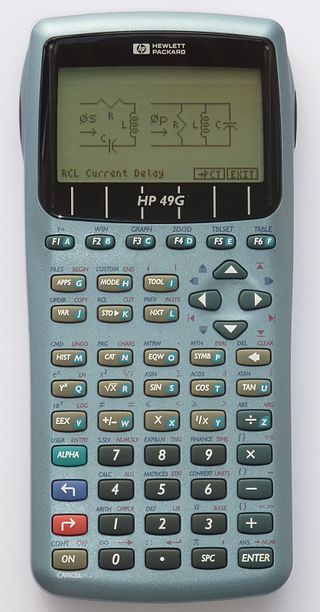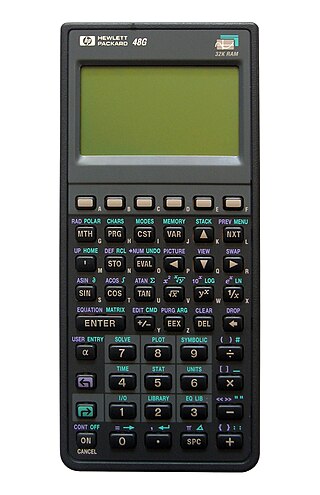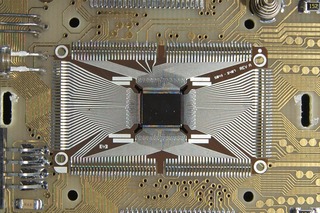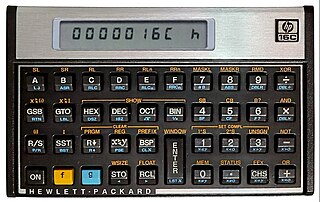A graphing calculator is a class of hand-held calculator that is capable of plotting graphs and solving complex functions. While there are several companies that manufacture models of graphing calculators, Hewlett-Packard is a major manufacturer.
The following table compares general and technical information for Hewlett-Packard graphing calculators:
| Model | Processor | Memory | Display | Input method | Stack | Programming languages | Computer algebra system | Character set | Sound | Connectivity | Power supply | Release year | Predecessors | Successors |
|---|---|---|---|---|---|---|---|---|---|---|---|---|---|---|
 HP Prime G2 (2AP18AA) | 528 MHz NXP i.MX 6ULL MCIMX6Y2 (Cortex A7 core, ARMv7 architecture) | 256 MB RAM, 512 MB flash | 320×240 pixel 16-bit color multi-touch TFT LCD with backlight | Algebraic, Entry RPN | Fixed (128 level) | PPL | Xcas/Giac-based | Unicode | No | USB (Micro-AB) USB-OTG | USB-rechargeable 3.7 V/2000 mAh/7.4 Wh Li-Ion, USB | 2018–present | HP Prime G1 | None |
 HP Prime G1 (NW280AA, G8X92AA) | 400 MHz Samsung S3C2416XH-40 (ARM926EJ core, ARMv5 architecture) | 32 MB RAM, 256 MB flash | 320×240 pixel 16-bit color multi-touch TFT LCD with backlight | Algebraic, Entry RPN | Fixed (128 level) | PPL | Xcas/Giac-based | Unicode | No | USB (Micro-AB) (USB-OTG only with G8X92AA model) | USB-rechargeable 3.7 V/1500 mAh/5.55 Wh Li-Ion (compatible: Samsung Galaxy S3 2200 mAh), USB | 2013–2017 | HP 39gII, (HP 50g) | HP Prime G2 |
 HP 50g blue (NW240AA) | 75 MHz (203 MHz) Samsung S3C2410A [1] (ARM920T core, ARMv4T architecture) | 512 KB RAM, 2 MB flash, expandable via 2 GB SD card | 131×80 pixel monochrome LCD | Entry RPN, Algebraic | Dynamic | RPL, Algebraic RPL | Erable-based | 8-bit RPL character set (with euro sign [2] [3] [4] ) | Buzzer | USB (Mini-B), IrDA, 1×4-pin 3.3 V TTL serial (RS-232 via active converter) | 4×1.5 V (6 V) AAA, 1×3 V CR2032, USB | 2009–2012 [5] [6] [7] | HP 50g (hp 49g+) | (HP Prime) |
 HP 50g black (F2229A) | 75 MHz (203 MHz) Samsung S3C2410A [1] (ARM920T core, ARMv4T architecture) | 512 KB RAM, 2 MB flash, expandable via 2 GB SD card | 131×80 pixel monochrome LCD | Entry RPN, Algebraic | Dynamic | RPL, Algebraic RPL | Erable-based | 8-bit RPL character set (with euro sign [2] [3] [4] ) | Buzzer | USB (Mini-B), IrDA, 1×4-pin 3.3 V TTL serial (RS-232 via active converter) | 4×1.5 V (6 V) AAA, 1×3 V CR2032, USB | 2006–2015 [5] [6] [7] | hp 49g+ | (HP Prime) |
 hp 49g+ (F2228A) | 75 MHz (203 MHz) Samsung S3C2410X01 (ARM920T core, ARMv4T architecture) | 512 KB RAM, 2 MB flash, expandable via 2 GB SD card | 131×80 pixel monochrome LCD | Entry RPN, Algebraic | Dynamic | RPL, Algebraic RPL | Erable-based | 8-bit RPL character set (with euro sign [2] [3] [4] ) | Buzzer | USB (Mini-B), IrDA | 3×1.5 V (4.5 V) AAA, 1×3 V CR2032 | 2003–2006 | HP 49G | HP 50g |
 HP 48gII (F2226A) | 48 MHz (203 MHz) Samsung S3C2410X01 (ARM920T core, ARMv4T architecture) | 128 KB RAM (256 KB RAM - 2007 model only), not flashable | 131×64 pixel monochrome LCD | Entry RPN, Algebraic | Dynamic | RPL, Algebraic RPL | Erable-based | 8-bit RPL character set (with euro sign [3] [4] ) | Buzzer | (USB (Mini-B) - 2007 model only), IrDA, 1×4-pin 3.3 V TTL serial (RS-232 via active converter) | 3×1.5 V (4.5 V) AAA (4×1.5 V (6 V) AAA - 2007 model only), 1×3 V CR2032, USB (2007 model only) | 2003 | HP 48G+ | HP 49g+ |
 HP 49G (F1633A, F1896A) | 4 MHz Yorke (Saturn 1LT8 core) | 512 KB RAM, 2 MB flash | 131×64 pixel monochrome LCD | Entry RPN, Algebraic | Dynamic | RPL, Algebraic RPL | Erable-based | 8-bit RPL character set (with euro sign [3] [4] ) | Buzzer | 2×5-pin RS-232 | 3×1.5 V (4.5 V) AAA | 1999–2003 | HP 48GX, HP 48G+ | hp 49g+ |
| HP 48G+ (F1630A, F1894A) | 4 MHz Yorke (Saturn 1LT8 core) | 128 KB RAM, not flashable | 131×64 pixel monochrome LCD | Entry RPN | Dynamic | RPL | Rudimentary [8] | 8-bit RPL character set [9] [10] | Buzzer | 1×4-pin RS-232, HP SIR | 3×1.5 V (4.5 V) AAA | 1998–2003 [11] | HP 48G | HP 49G |
 HP 48G | 3.68-4 MHz Yorke (Saturn 1LT8 core) | 32 KB RAM, not flashable | 131×64 pixel monochrome LCD | Entry RPN | Dynamic | RPL | Rudimentary [8] | 8-bit RPL character set [9] [10] | Buzzer | 1×4-pin RS-232, HP SIR | 3×1.5 V (4.5 V) AAA | 1993–2003 [11] | HP 48S | HP 48G+, HP 49G |
 HP 48GX (F1895A) | 4 MHz Yorke (Saturn 1LT8 core) | 128 KB RAM, expandable via 128 KB and 4 MB max. card slots, not flashable | 131×64 pixel monochrome LCD | Entry RPN | Dynamic | RPL | Rudimentary [8] | 8-bit RPL character set [9] [10] | Buzzer | 1×4-pin RS-232, HP SIR | 3×1.5 V (4.5 V) AAA | 1993–2003 [11] | HP 48SX | HP 49G |
 HP 48S | 2 MHz Clarke (Saturn 1LT8 core) | 32 KB RAM, not flashable | 131×64 pixel monochrome LCD | Entry RPN | Dynamic | RPL | Rudimentary [8] | 8-bit RPL character set | Buzzer | 1×4-pin RS-232, HP SIR | 3×1.5 V (4.5 V) AAA | 1991–1993 [11] | HP-28S | HP 48G |
| HP 48SX | 2 MHz Clarke (Saturn 1LT8 core) | 32 KB RAM, expandable via 2 card slots of 128 KB RAM/ROM each, not flashable | 131×64 pixel monochrome LCD | Entry RPN | Dynamic | RPL | Rudimentary [8] | 8-bit RPL character set | Buzzer | 1×4-pin RS-232, HP SIR | 3×1.5 V (4.5 V) AAA | 1990–1993 [11] | HP-28S | HP 48GX |
 HP 39gII (NW249AA) | 80 MHz Freescale (formerly SigmaTel) STMP3770 (ARM926EJ-S core) | 256 KB RAM (ca. 240 KB available to user), 128 MB flash (80–105 MB available to user) | 256×128 pixel monochrome gray-scale LCD | Algebraic | Dynamic | HP Basic-variant or PPL-predecessor? | No | Unicode | No | USB-OTG (Micro-AB) | 1–4×1.5 V (1.5 V) AAA, USB | 2011 | HP 39gs | HP Prime |
 HP 40gs (F2225A) | 75 MHz Samsung S3C2410A (ARM920T core, ARMv4T architecture) | 256 KB RAM, 2 MB flash | 131×64 pixel monochrome LCD | Algebraic | Dynamic | HP Basic | Erable-based | 8-bit RPL character set (with −1 [12] and euro sign [12] ) | Buzzer | USB (Mini-B), 1×4-pin 3.3 V TTL serial (RS-232 via active converter) | 4×1.5 V (6 V) AAA, 1×3 V CR2032, USB | 2006–2011 | HP 40G | HP 39gII, HP Prime |
 HP 39gs (F2223A) | 75 MHz Samsung S3C2410A (ARM920T core, ARMv4T architecture) | 256 KB RAM, 1 MB flash | 131×64 pixel monochrome LCD | Algebraic | Dynamic | HP Basic | No | 8-bit RPL character set (with −1 [12] and euro sign [12] ) | Buzzer | USB (Mini-B), IrDA, 1×4-pin 3.3 V TTL serial (RS-232 via active converter) | 4×1.5 V (6 V) AAA, 1×3 V CR2032, USB | 2006–2011 | hp 39g+ | HP 40gs, HP 39gII |
 hp 39g+ (F2224A) | 75 MHz Samsung S3C2410X (ARM920T core, ARMv4T architecture) | 256 KB RAM, 1 MB flash | 131×64 pixel monochrome LCD | Algebraic | Dynamic | HP Basic | No | 8-bit RPL character set (with −1 [12] and euro sign) | Buzzer | USB (Mini-B), IrDA | 3×1.5 V (4.5 V) AAA, 1×3 V CR2032 | 2003–2006 | HP 39G | HP 39gs |
| HP 40G (F1907A) | 4 MHz Yorke (Saturn 1LT8 core) | 256 KB RAM, not flashable | 131×64 pixel monochrome LCD | Algebraic | Dynamic | HP Basic | Erable-based | 8-bit RPL character set (with −1 [12] and euro sign) | Buzzer | 2×5-pin RS-232 | 3×1.5 V (4.5 V) AAA | 2000–2003 | HP 38G | HP 40gs |
| HP 39G (F1906A) | 4 MHz Yorke (Saturn 1LT8 core) | 256 KB RAM, not flashable | 131×64 pixel monochrome LCD | Algebraic | Dynamic | HP Basic | No | 8-bit RPL character set (with −1 [12] and euro sign) | Buzzer | IrDA, 2×5-pin RS-232 | 3×1.5 V (4.5 V) AAA | 2000–2003 | HP 38G | hp 39g+ |
 HP 38G (F1200A, F1892A) | 4 MHz Yorke (Saturn 1LT8 core) | 32 KB RAM, not flashable | 4-line (131×64 pixel) monochrome LCD | Algebraic | Dynamic | HP Basic | No | 8-bit RPL character set [12] | Buzzer | HP SIR, 2×5-pin RS-232 | 3×1.5 V (4.5 V) AAA | 1995 | None | HP 39G, HP 40G |
| HP-28S | 1 MHz Lewis (Saturn 1LT8 core) | 32 KB RAM, not flashable | 4-line (137×32 pixel) monochrome LCD | Entry RPN | Dynamic | RPL | Rudimentary [8] | 8-bit HP Roman 8 variant [13] [14] [15] | Buzzer | HP SIR | 3×1.5 V (4.5 V) N | 1988–1992 | HP-28C | HP 48 series |
| HP-28C | 640 kHz Saturn (Saturn 1LK7 core) | 2 KB RAM, 1709? bytes RAM available for user, not flashable | 4-line (137×32 pixel) monochrome LCD | Entry RPN | Dynamic | RPL | Rudimentary [8] | 8-bit HP Roman 8 variant | Buzzer | HP SIR | 3×1.5 V (4.5 V) N | 1987–1988 | HP-41C | HP-28S |
| HP-42S | 1 MHz Lewis (Saturn core) | 8 KB RAM (extensible to 32 KB), 7200? (or 31553) bytes RAM available for user, not flashable | 2-line (131×16 pixel) monochrome LCD | Classical RPN | Fixed (4 level) | Keystroke programmable, fully merged (FOCAL variant) | None | 8-bit proprietary | Buzzer | HP SIR | 3×1.5 V (4.5 V) LR44 | 1987–1995 | HP-41C, (HP-15C) | HP-28S |
 HP 9g | Sunplus SPLB30A (aka Generalplus GPLB30A) | 712? bytes RAM available for user, not flashable | 35×23 pixel, 1-line 5-digit 5×7 dot matrix, 1-line 10+3-digit 7-segment monochrome LCD | Algebraic | ? | Limited, 10 programmable "expression registers" that can reference other functions, registers, and memory | No | ? | No | None | 1×3 V CR2025 | 2003 | None | None |
| Model | Processor | Memory | Display | Input method | Stack | Programming languages | Computer algebra system | Character set | Sound | Connectivity | Power supply | Release year | Predecessors | Successors |

